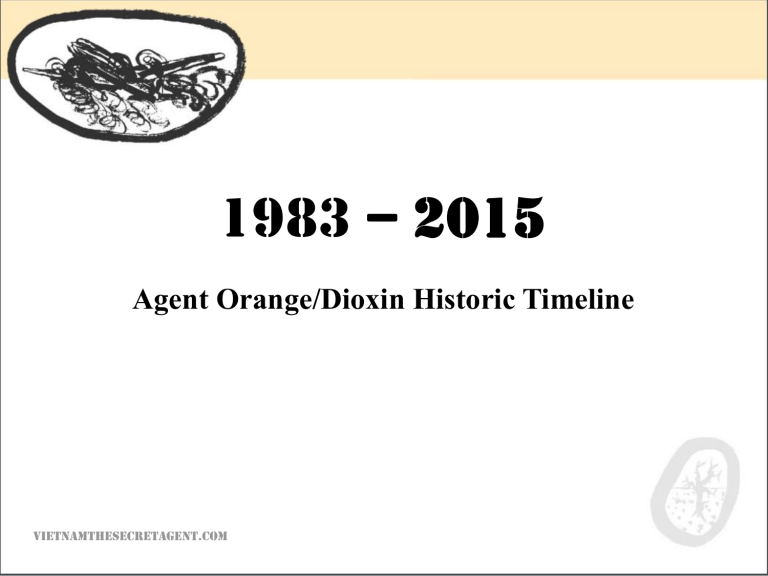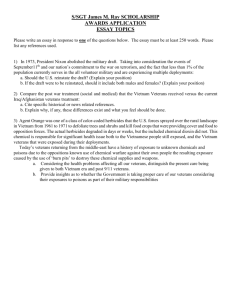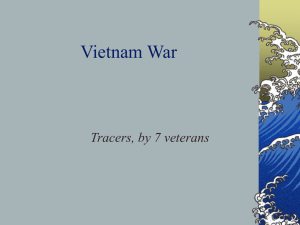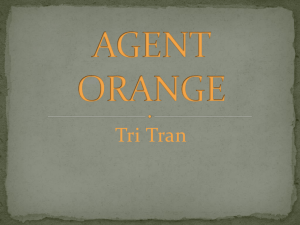PowerPoint pptx file - VietnamTheSecretAgent.com

1983 – 2015
Agent Orange/Dioxin Historic Timeline
VIETNAMTHESECRETAGENT.COM
1983
February
The U.S. government spends $33,000,000 buying out the town of Times Beach, Missouri and relocates its 2,200 residents.
Following the sudden death of 62 horses in 1971, owners suspected waste oil used to tamp down dust in the stable as the cause. They brought their concerns to the Centers for Disease Control and
Prevention which began investigating the Times
Beach area. From 1971–1976 the same waste oil was used on roads to combat dust problems in Times
Beach. In 1979 a company confessed to mixing dioxin laden waste oil with conventional waste oil.
The EPA visited in 1982 and announced it had identified dangerous levels of dioxin in Times Beach soil some 300 times the level considered safe. The subsequent clean-up cost the U.S. government $110 million, with $10 million reimbursed by the company that originally sold the oil product.
VIETNAMTHESECRETAGENT.COM
1983
June
In response to the Times Beach incident, the American Medical Association adopts a resolution calling for a public information campaign on dioxin to
“prevent irrational reaction and unjustified public fright.”
That report says that while dioxin “may well be one of the most toxic substances known to man,” there is “still very little substantive evidence for many of the alleged claims made against the compound.”
VIETNAMTHESECRETAGENT.COM
1984
May
In October 1983, the consortium of attorneys for American Vietnam veterans, headed by
Victor Yannacone, declares inability to fund the litigation further and appeals to Judge Jack
Weinstein to appoint a Plaintiff’s Management Committee (PMC). Victor Yannacone loses all decision-making powers and three new law firms take control within PMC.
The Vietnam Veterans’ Agent Orange lawsuit is settled on the morning of the opening day of trial. Under the terms of the settlement, the veterans who claim exposure to Agent
Orange receive $180 million from the chemical companies.
But those companies do not have to admit culpability for any injuries that occurred as a result of Agent Orange exposure. The U.S. government is not a party to the litigation.
The settlement leads to roughly 50,000 people receiving small compensation ($5,000 or less). Following an initial request for a $40,000,000 legal fee, Judge Weinstein grants the law firms a fee of $9.2 million.
VIETNAMTHESECRETAGENT.COM
1984
October
Congress passes Public Law 98-542, designed to provide compensation to Vietnam veterans for soft tissue sarcoma and requiring the Veterans
Administration [VA] to establish standards for Agent Orange and atomic radiation compensation.
VIETNAMTHESECRETAGENT.COM
A Federal district
Administration’s regulations on health damage attributed to the herbicide Agent Orange, ordering the agency to reconsider claims of more than 31,000 Vietnam War veterans.
Despite Public Law 98-542, the VA has been requiring proof that the herbicide caused certain illnesses. As a result they have primarily been treating and compensating veterans suffering from chloracne.
VIETNAMTHESECRETAGENT.COM
1989
1991
January
Agent Orange Act of 1991 Public Law 102-4
This Agent Orange Act gives the Department of Veterans Affairs the authority to declare certain conditions ‘presumptive’ to exposure to
Agent Orange/Dioxin. This law makes veterans who served in
Vietnam eligible to receive treatment and compensation for these conditions without having to prove exposure to herbicides.
Conditions include: Hodgkin’s disease, multiple myeloma, Non-
Hodgkin’s lymphoma, Porphyria cutanea tarda, respiratory cancers, soft-tissue sarcoma, Chloracne.
VIETNAMTHESECRETAGENT.COM
President Clinton orders VA disability benefits expanded to cover veterans who served in Vietnam and suffer from prostate cancer or a nerve disease.
VIETNAMTHESECRETAGENT.COM
1996
May
1996
october
Veterans’ Health Care Eligibility Reform Act of 1996 stipulates that the VA must provide its Medical Benefits Package – including outpatient and inpatient medical care at VA facilities, prescription medications and home health and hospice care – to veterans with disorders associated with herbicide exposure in Vietnam.
VIETNAMTHESECRETAGENT.COM
1996
july
1998
July
Appointment of the first
U.S. ambassador to the
Socialist Republic of
Vietnam.
The Vietnam Red Cross establishes the Vietnam
Agent Orange Victims Fund to provide direct assistance to families throughout Vietnam impacted Agent Orange.
VIETNAMTHESECRETAGENT.COM
VIETNAMTHESECRETAGENT.COM
1999
November
A South Korean organization, The Association of Vietnam War Veterans Suffering from
Exposure to Agent Orange, wages a legal battle for compensation for the South Korean veterans who fought in Vietnam and were exposed.
The organization is seeking $4.3 billion from two U.S. Agent Orange manufacturers. Dow
Chemical and Monsanto, and another $1 billion from the US government.
[See 2006]
2000
March
Defense Secretary William Cohen pledges greater U.S. cooperation with
Vietnam’s Agent Orange problems during a trip to Hanoi. Eight months later, during President Clinton’s fiveday trip to Vietnam, the United States and Vietnam agree to set up a joint research study on the effects of dioxin/Agent Orange.* [*see March
2005]
Study by The Air Force claims a link between Agent Orange and adultonset diabetes in veterans.
VIETNAMTHESECRETAGENT.COM
The Veterans’ Administration recognizes that Agent Orange was used in Korea in the late 1960’s and approves Agent Orange examinations for U.S. veterans who served in Korea in 1968 or 1969. The VA takes this action despite reports that Republic of
Korea troops, not US military personnel, did the actual spraying.
The government of South Korea reports that as many as 50,000 South Korean veterans may have been exposed during spray operations there.
VIETNAMTHESECRETAGENT.COM
2000
September
VIETNAMTHESECRETAGENT.COM
2001
May
At the first Stockholm
Convention on Persistent
Organic Pollutants, 128 parties and 151 signatories ratify an international environmental treaty that aims to eliminate or restrict the production and use of persistent organic pollutants, including dioxin.
2002
The United States and Vietnam sign a memorandum of understanding that specifies future collaborative research on the human health and environmental effects of Agent Orange and dioxin, as well as creating a Joint Advisory Committee to oversee such collaboration.
Following the conference the U.S. National Institute of
Environmental and Health Sciences (NIEHS) begins scientific exchanges between the US and Vietnam and discussions for a joint research project on the human health impacts of Agent Orange.
VIETNAMTHESECRETAGENT.COM
2003
Vietnam Association of Victims of Agent Orange (VAVA) is formed in Vietnam. VAVA provides medical care, rehabilitation services and financial assistance to those impacted by Agent Orange.
[see Jan. 2004, March 2005, Feb. 2008]
2004
January
VAVA sues the U.S. chemical companies responsible for producing the chemicals used during the war.
VIETNAMTHESECRETAGENT.COM
2005
The EPA begins to work with the Vietnamese government to measure the level of dioxin at the former Da Nang
Airbase.
March
The VAVA suit is dismissed in 2005 by Judge Jack
Weinstein (who settled the American veteran lawsuit in 1984) ruling that there is no legal basis for the plaintiffs’ claims. He states that there was no law between 1961 and 1971 prohibiting wartime use of defoliants. The decision is appealed.
Negotiations between Vietnam and the U.S., started in 2000 to set up a joint research project studying affects of Agent Orange on the Vietnamese population, break down in 2005 when both sides can not agree on the research protocol. The research project is canceled.* [*See March 2000]
VIETNAMTHESECRETAGENT.COM
2006
January
Dow Chemical, Monsanto and other U.S. makers of Agent Orange are ordered to pay damages to South Korean veterans of the Vietnam War in a South Korean court. Approximately 7,000 veterans out of 17,200 who filed may be awarded from $5,000 – $40,000. Total award is
$63,000,000. The court has little jurisdiction to enforce.
VIETNAMTHESECRETAGENT.COM
2006
The Joint Advisory Committee on Agent Orange made up of U.S. and
Vietnamese government officials and experts holds its first meeting to explore areas of scientific cooperation, technical assistance and environmental remediation of dioxin hotspots. Additional meetings are held in 2008 and 2009
DECEMBER
Congress passes P.L. 109-432, a comprehensive trade and tax bill, that grants Vietnam permanent Normal Trade Relations status as part of a wider agreement that sees Vietnam become a member of the World
Trade Organization (WTO) on January 11, 2007.
VIETNAMTHESECRETAGENT.COM
2007
May
President George W. Bush signs into law a supplemental spending bill for the
Iraq/Afghanistan wars that includes an earmark — $3 million for programs for the remediation of dioxin ‘hotspots’ on former U.S. military bases in Vietnam and for public health programs for the surrounding communities. It takes over a year for the government to determine how to use these funds.
$500,000 is budgeted to hire and support a full-time environmental remediation advisor for two years, posted at the U.S. Embassy in Hanoi.
Half the funding is budgeted for environmental containment and remediation planning at the Da Nang airport. The remaining $1 million is allocated to three nongovernmental organizations (NGOs) operating in Vietnam providing assistance to people with disabilities, mostly around Da Nang.
VIETNAMTHESECRETAGENT.COM
2008
February
The 2nd U.S. Circuit Court of Appeals in Manhattan upholds the decision by Judge Jack Weinstein that the U.S. chemical companies did not commit war crimes or intentionally cause harm by providing defoliants to the U.S. government for use during the Vietnam war.
In a separate opinion, the appellate court also says companies are protected from lawsuits brought by U.S. military veterans or their relatives because they are protected as government contractors.
VIETNAMTHESECRETAGENT.COM
2009
February
Conference attendees of the United Nations Development
Program agree on two goals—immediate containment of dioxin-contaminated soil at the three major known “hot spots” (Bien Hoa, Da Nang, and Phu Cat), and a longer term goal of dioxin destruction to completely eliminate dioxin from contained soil and sediment.
Attending the meeting are representatives of the U.S. State
Department, USAID, and the U.S. Environmental Protection Agency.
VIETNAMTHESECRETAGENT.COM
2009
MARCH
Congress appropriates an additional $3 million for dioxin removal and health care facilities in Da Nang.
U.S. Supreme Court refuses to hear the appeal of the VAVA case against chemical companies as decided by the U.S. Court of Appeals in 2008, as well as two other suits filed by American veterans who were taken ill after the 1984 class action settlement.
The Court of Appeals decision stands.
VIETNAMTHESECRETAGENT.COM
2009
MAY
The Department of Veterans Affairs establishes AL Amyloidosis as a new presumptive condition on the Agent Orange/herbicide list. The Institute of Medicine concludes in a report that there is suggestive evidence of association between exposures to herbicides and the disease.
AL Amyloidosis (am-uh-loi-DO-sis) is a rare blood cell disorder that shares biological features of some lymphomas already associated with herbicide exposure in previous IOM reports.
VIETNAMTHESECRETAGENT.COM
2009
SEPTEMBER
A new scientific study, conducted by Vancouver based Hatfield
Consultants, shows direct link from dioxin contaminated hot spots in Vietnam to the blood and breast milk of humans by tracking dioxin’s chemical fingerprint; tracing its movement through the food chain from the soil and lake sediment to the fat of fish and ducks to humans.
OCTOBER
Department of Veterans Affairs establishes a service-connection for
Vietnam veterans with B cell leukemias, such as hairy cell leukemia, Parkinson’s disease and ischemic heart disease
VIETNAMTHESECRETAGENT.COM
2010
AUGUST
Parkinson’s disease, ischemic heart disease, and B cell leukemia(s)
(including hairy cell leukemia) are finally added by congress to list of “presumptive” Agent orange conditions.
More than 150,000 veterans are expected to submit claims in the next 12 to 18 months, many of whom are potentially eligible for retroactive disability payments based on past claims. Additionally, VA will review approximately 90,000 previously denied claims by Vietnam Veterans.
VIETNAMTHESECRETAGENT.COM
2011
FEBRUARY
Passing of Agent Orange Equity Act of 2011: Expands veterans entitled to presumptive benefits to those who had contact with the Republic of Vietnam’s inland waterways, ports, harbors, waters offshore, and airspace. Includes as veterans eligible those who:
1) Served on Johnston Island during the period of April,
1972 — September, 1977.
2) Received the Vietnam Service Medal or the Vietnam
Campaign Medal.
VIETNAMTHESECRETAGENT.COM
2011
JULY
H.R. 2634 : Victims of Agent Orange Relief Act of 2011 introduced in Congress by Reps Bob Filner, John Conyers,
Barney Frank, Raul Grijalva and Barbara Lee.
If passed would, in part, direct the Secretary of State to provide assistance to certain individuals affected by exposure to Agent
Orange who reside in Vietnam. It would also direct the Department of Veterans Affairs to establish at least two VA regional medical centers to address the medical needs of descendants of Vietnam era veterans. This bill was not enacted.
VIETNAMTHESECRETAGENT.COM
2012
AUGUST
After years of rebuffing Vietnamese requests for assistance in a cleanup, the United States inaugurates its first major effort to address the environmental effects of the war in Vietnam. Together, the United States and Vietnam begin cleaning up the toxic chemical defoliant Agent Orange in part of Danang International Airport.
The process is expected to take up to four years and cost about 43 million dollars.
VIETNAMTHESECRETAGENT.COM
2013
January
HR 411: Fort McClellan Health Registry Act
This bill sought to create a registry for veterans stationed at the base to help them get coverage for health issues stemming from their exposure to toxins, and open up disability payments.
However, the bill was referred to a committee where it was not enacted.
VIETNAMTHESECRETAGENT.COM
2013
February
HR543: The “Blue Water Navy Vietnam Veterans Act of
2013” is introduced to the US senate.
This bill, if passed, will grant disability aid to diseased veterans who served in the navy or in the Republic of
Vietnam’s territorial seas during the Vietnam war and were exposed to certain herbicide agents.
VIETNAMTHESECRETAGENT.COM
2014
April
HR 1769: “Toxic Exposure Research Act of 2015”
This legislation directs the VA secretary to select one VA Medical
Center to serve as the national center for the research of the diagnosis and treatment of health conditions of descendants of individuals exposed to toxic substances while serving in the Armed Forces. The toxic research act was introduced to the House from committee on
July 31, 2014, but was not enacted.
VIETNAMTHESECRETAGENT.COM
2015
JANUARY
Institute of Medicine of the National Academy of Sciences reports on Agent Orange to the Veterans Administration
Institute of Medicine reports that Air Force Reserve personnel who trained or worked on C-123 aircraft, which had previously been used to spray herbicides including Agent Orange during the Vietnam War (Operation Ranch Hand), could have been exposed to increased health risk (e.g. 200 fold risk for cancer), from exposure to herbicide residue on and within these aircraft.
VIETNAMTHESECRETAGENT.COM
2015
MARCH
HR 969 (formerly HR 543) “The Blue Water Navy Vietnam
Veterans Act of 2015” is reintroduced as possible legislation and referred to a subcommittee on Disability and Medical
Affairs.
VIETNAMTHESECRETAGENT.COM
2015
MAY
Hearings were held for S 681(the Senate version of HR 969),
“The Blue Water Navy Vietnam Veterans Act of 2015,” on
5/13/15 by the Senate Committee of Veterans affairs.
The act is currently under the committee’s consideration.
VIETNAMTHESECRETAGENT.COM
For more resources on Agent Orange, its use in
Vietnam and its continued effects on those exposed and their progeny, visit http://www.vietnamthesecretagent.com
VIETNAMTHESECRETAGENT.COM






